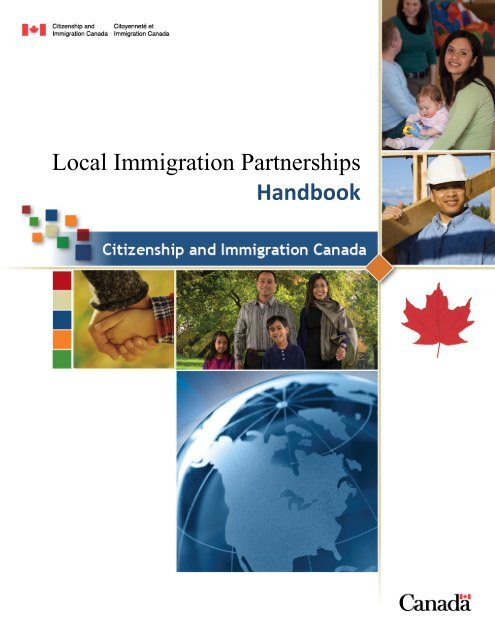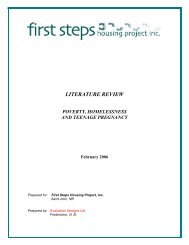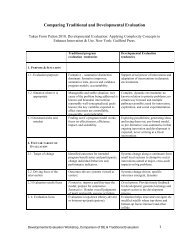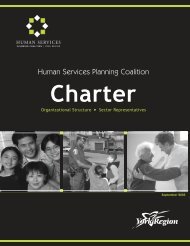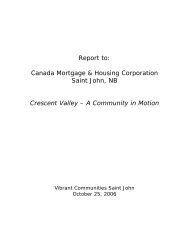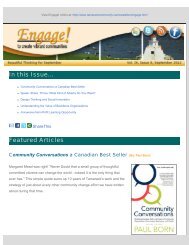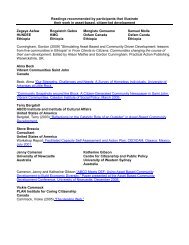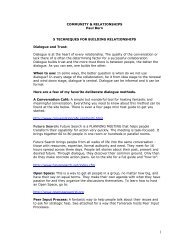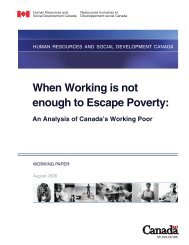Local Immigration Partnerships Handbook - Tamarack
Local Immigration Partnerships Handbook - Tamarack
Local Immigration Partnerships Handbook - Tamarack
Create successful ePaper yourself
Turn your PDF publications into a flip-book with our unique Google optimized e-Paper software.
<strong>Local</strong> <strong>Immigration</strong> <strong>Partnerships</strong><br />
<strong>Handbook</strong><br />
1
Table of Contents<br />
Introduction<br />
Conceptualizing Community<br />
• Community<br />
• Welcoming Communities<br />
• Integration<br />
• Characteristics of a Welcoming Community<br />
<strong>Local</strong> Context: Building on Success<br />
Purpose of the <strong>Local</strong> <strong>Immigration</strong> <strong>Partnerships</strong> (LIPs)<br />
• What are the LIPs<br />
• Steps in the LIPs Process<br />
• What did we expect<br />
What does success look like<br />
• Refined Purpose of the LIPs<br />
• Ideal Partnership Council Membership<br />
o Community Engagement<br />
• Comprehensive Community Consultation and Research<br />
• Key Components of a Strategic Plan<br />
• Appropriate Costing<br />
Further Information<br />
• Welcoming Communities Initiative (WCI)<br />
• Horizons<br />
• Key readings<br />
2
Introduction<br />
Since the mid‐1990s, Citizenship and <strong>Immigration</strong> Canada (CIC) has increasingly recognized the<br />
importance of engagement at the local level. Municipalities play a central role in delivering<br />
many services that impact the integration outcomes of newcomers; tremendous capacity and<br />
expertise exist at the local level.<br />
Communities across Canada are recognizing the importance of newcomers, and are making<br />
immigration a main component of their plans for the future, both at the provincial and<br />
territorial level and increasingly, at the municipal level.<br />
Municipalities are taking a greater role in planning for and guiding immigration and settlement.<br />
Critical gaps have been identified in the local labour force with corresponding attraction<br />
strategies being developed. Retention is a key concern for many communities, given the reality<br />
that entire families need to feel welcomed for workers to stay.<br />
Citizenship and <strong>Immigration</strong> Canada (CIC) and provinces with delegated settlement<br />
responsibilities have been working on attraction and retention for some time, as evidenced by:<br />
• Small Centres Toolbox<br />
(http://www.icavictoria.org/services/resources/toolbox‐ideas)<br />
• Manitoba Rural <strong>Immigration</strong> Community Case Studies<br />
(http://www2.brandonu.ca/organizations/rdi/Publications/<strong>Immigration</strong>/Lessons‐<br />
Final.pdf)<br />
• Quebec Regionalization Action Plans<br />
• (http://www.immigration‐quebec.gouv.qc.ca/en/settle/index.html and see Rimok and<br />
Rouzier chapter in Ontario <strong>Immigration</strong>, Integration, and Inclusion in Ontario Cities)<br />
• BC Welcoming Communities<br />
(http://www.welcomebc.ca/wbc/communities/building_a_strong_community/index.pa<br />
geWT.svl=Body)<br />
• Welcoming Communities components of Canada’s Action Plan Against Racism (CAPAR),<br />
which are now encapsulated in the Community Connections stream of CIC’s modernized<br />
Settlement Program<br />
The <strong>Local</strong> <strong>Immigration</strong> <strong>Partnerships</strong> (LIPs) innovation is a means to systematize local<br />
engagement in settlement with resources available to hire individuals to coordinate the<br />
activities of the LIP, to build on existing local initiatives, to contribute to the enhanced planning<br />
envisioned in the 2008 modernized approach to settlement, and to augment engagement of<br />
"host" populations in the two‐way street model of integration.<br />
This <strong>Handbook</strong> is intended to assist communities and CIC Settlement Staff in establishing <strong>Local</strong><br />
<strong>Immigration</strong> <strong>Partnerships</strong> (LIPs) as a means of planning and coordination at the local level with<br />
municipal, provincial/territorial and federal involvement.<br />
3
Conceptualizing Community<br />
Community is a unified body of individuals who may be linked by a common location,<br />
shared interests, similar history, or a set of values and beliefs.<br />
Welcoming Communities are places that have a strong desire to receive newcomers and<br />
where everyone works to create an environment within which newcomers feel at home.<br />
Integration is a two‐way process that encourages adjustments on the part of both<br />
newcomers and the host society. Ultimately, the goal is to support newcomers to become<br />
fully engaged in the economic, social, political and cultural life of Canada.<br />
Characteristics of a Welcoming Community<br />
As the destinations of newcomers have begun to diversify over the last decade and<br />
demographic change has made immigration a growing necessity, an emphasis on both<br />
attracting and retaining immigrants has resulted in an increased emphasis on the role of<br />
community. The result has been an increase in initiatives to build welcoming communities,<br />
including:<br />
• CAPAR<br />
• (http://dsp‐psd.pwgsc.gc.ca/Collection/CH34‐7‐2005‐1E.pdf)<br />
• British Columbia<br />
(http://www.welcomebc.ca/wbc/communities/index.pageWT.svl=Topnav)<br />
• Alberta<br />
• (http://www.healthyalberta.com/HealthyPlaces/759.htm)<br />
• Manitoba<br />
(http://www.gov.mb.ca/chc/multi_sec/wcm.html)<br />
• New Brunswick<br />
(http://canada.metropolis.net/events/metropolis_presents/Metropolis_presents_Welc<br />
oming_Seminar/Sheehan‐E.pdf)<br />
• Nova Scotia<br />
(http://novascotiaimmigration.ca/communities/getting‐started)<br />
4
• Welcoming Communities Initiative‐Community University Research Alliance (WCI‐<br />
CURA), which is a network focused on conducting research and offering resources to<br />
help cities in Ontario attract and fully integrate newcomers<br />
(http://welcomingcommunities.ca/)<br />
In March 2010, Victoria Esses, Leah Hamilton, Caroline Bennett‐AbuAyyash and Meyer Burstein<br />
authored a study called Characteristics of a Welcoming Community, which highlighted the 17<br />
factors which contribute to an open and inclusive environment. Their research was based on<br />
an extensive survey of the relevant scholarly literature, government (federal,<br />
provincial/territorial, and municipal) and community reports, descriptions of best practices, and<br />
case examples from the public and private sectors.<br />
The rank ordered list includes:<br />
1. Employment Opportunities<br />
2. Fostering of Social Capital<br />
3. Affordable and Suitable Housing<br />
4. Positive Attitudes toward Immigrants, Cultural Diversity, and the<br />
Presence of Newcomers in the Community<br />
5. Presence of Newcomer‐Serving Agencies that can Successfully Meet<br />
the Needs of Newcomers<br />
6. Links between Main Actors Working toward Welcoming<br />
Communities<br />
7. Municipal Features and Services Sensitive to the Presence and<br />
Needs of Newcomers<br />
8. Educational Opportunities<br />
9. Accessible and Suitable Health Care<br />
10. Available and Accessible Public Transit<br />
11. Presence of Diverse Religious Organizations<br />
12. Social Engagement Opportunities<br />
13. Political Participation Opportunities<br />
14. Positive Relationships with the Police and the Justice System<br />
15. Safety<br />
16. Opportunities for Use of Public Space and Recreation Facilities<br />
17. Favourable Media Coverage and Representation<br />
5
<strong>Local</strong> Context: Building on Success<br />
Municipalities, communities and neighbourhoods have been organizing and planning to address<br />
the needs and interests of newcomers for some time. The LIPs model is a complement to<br />
existing activities and can be implemented to leverage capacity.<br />
LIPs not only complement existing activities, but also help to more fully integrate and optimize<br />
these activities. In addition, LIPs build on current successes in the community, and work with<br />
what is already in place, rather than supplanting other efforts or working in parallel. As LIPs<br />
mature, new practices, new partnerships and new ways of working will emerge.<br />
LIPs systematize initiatives while supporting bridging between settlement service provider<br />
organizations (SPOs) and mainstream organizations. Further, the presence of LIPs provides<br />
structure and staff to ensure coherence and maintain momentum within a community.<br />
Purpose of the <strong>Local</strong> <strong>Immigration</strong> <strong>Partnerships</strong> (LIPs)<br />
What are the LIPs<br />
<strong>Local</strong> <strong>Immigration</strong> <strong>Partnerships</strong> (LIPs) are the mechanism through which CIC supports the<br />
development of community‐based partnerships and planning around the needs of newcomers.<br />
LIPs seek to engage various stakeholders in a locally‐driven strategic planning process including<br />
employers, school boards, health centres and networks, boards of trade, levels of government,<br />
professional associations, ethno‐cultural organizations, faith‐based organizations, and the<br />
community and social services sectors.<br />
<strong>Local</strong> <strong>Immigration</strong> <strong>Partnerships</strong> are steered by broad‐based coordinating councils comprised of<br />
key community members, often representing important local organizations. The partnership<br />
councils are tasked with overall stewardship and management control over initiatives such as<br />
needs assessments and asset mapping of their community. The partnership council’s main goal<br />
is to oversee the development of a local settlement strategy and targeted action plan to<br />
produce a more welcoming and inclusive community. A staffed secretariat facilitates this<br />
process for the council by coordinating and providing organizational support. Many partnership<br />
councils have formed sub‐committees (Steering and Executive Committees) as well as working<br />
groups or sector tables focused on particular themes, such as health and employment.<br />
<strong>Local</strong> <strong>Immigration</strong> <strong>Partnerships</strong> represent a new form of multi‐level governance involving<br />
municipal, provincial and federal partners. The long‐term vision for LIPs is to support the<br />
development of multi‐sectoral partnerships at the local community level to:<br />
• Integrate newcomer needs into the community planning process<br />
• Identify community‐specific strategic priorities<br />
• Implement a settlement strategy and action plans to improve newcomer outcomes<br />
6
The overall objective is to engage groups that will coordinate and enhance the current<br />
settlement and integration service delivery network, while avoiding duplication. Strategic<br />
partnerships between many stakeholders are encouraged to improve dialogue and information<br />
sharing between sectors, identify gaps, and align services. LIPs do not provide direct service<br />
delivery to clients, nor do they make funding decisions on behalf of CIC.<br />
Through regional Calls for Proposals (CFPs) for LIPs in 2008 and 2010, 45 LIPs have been<br />
gradually established in Ontario in two forms.<br />
• 1 city‐wide and 14 neighbourhood‐based LIPs in Toronto (total cost of $4 million)<br />
• 30 community‐wide LIPs in Ontario (total cost of $5.2 million)<br />
The cost per LIP ranges from $59.5K to $553.6K (one year). The average cost per LIP during the<br />
intense initial development period has been $226K (one year).<br />
Steps in the LIPs Process<br />
It is also important to note the essential organizational steps that build trust among<br />
stakeholders and commitment to the partnership. The role of community engagement,<br />
retention of a LIP coordinator, and the formation of working groups should not be overlooked.<br />
7
What did we expect<br />
In issuing the Calls for Proposals, CIC intended to:<br />
1. Strengthen local and regional awareness and capacity to integrate immigrants.<br />
2. Establish or enhance partnerships and participation of multiple stakeholders in planning,<br />
and coordinating the delivery of integration services.<br />
3. Improve access to, and coordination of, effective services that facilitate immigrant<br />
settlement and integration.<br />
4. Improve access to the labour market for immigrants.<br />
Who should hold the Contribution Agreement (CA)<br />
The LIPs in Ontario have developed in a variety of ways. Assigning responsibility for the CA<br />
needs to take the local context into account. Based on detailed analysis of existing LIPs, there<br />
are many examples of different models that have worked in Ontario.<br />
For example, the London‐Middlesex LIP is headed by the City and United Way as partners; in<br />
Ottawa, the Catholic <strong>Immigration</strong> Centre was delegated as the lead representative by executive<br />
directors of LASI (<strong>Local</strong> Agencies Serving Immigrants); and in Northern communities, including<br />
North Bay, the LIP has been embedded with municipal economic development entities.<br />
What does success look like<br />
In March 2010, The Standing Committee on Citizenship and <strong>Immigration</strong> recognized LIPs as a<br />
best practice and recommended that CIC continue to support and expand LIPs in Ontario and<br />
explore the potential for pilot projects in other interested provinces.<br />
The 2008 Ontario CFP for LIPs was deliberately broad to encourage innovation. Based on<br />
analysis, feedback and unanticipated outcomes, it was clear that CIC needed to revisit its<br />
definition of success for the LIPs. Best practices have been identified in the following areas to<br />
guide expansion in other regions.<br />
In October 2010, Minister of Citizenship and <strong>Immigration</strong> Jason Kenney stated that the LIPs are<br />
key to the future of settlement services in Canada.<br />
Please see the table on the following page.<br />
8
What does success look like<br />
Where we are…<br />
Where we hope to be…<br />
Newcomer needs<br />
assessed.<br />
Expanded number and<br />
diversity of<br />
stakeholders.<br />
<strong>Partnerships</strong><br />
developed for planning<br />
and setting priorities.<br />
Services coordinated at<br />
the community level<br />
and improved<br />
accessibility to<br />
mainstream<br />
institutions.<br />
Increased awareness<br />
of settlement services<br />
and thereby enhanced<br />
uptake.<br />
No standardized approaches<br />
or tools for newcomer needs<br />
assessment, or a method to<br />
derive a baseline.<br />
19 percent of SPOs using<br />
referrals; missing<br />
stakeholders from some<br />
partnership councils (e.g.<br />
media, police services,<br />
chambers of commerce).<br />
Limited interactions between<br />
various levels of government,<br />
mainstream organizations<br />
and community stakeholders.<br />
Partial coordination;<br />
duplication of some services;<br />
limited mechanisms for<br />
sharing information.<br />
Approximately 25 percent of<br />
newcomers use CIC language<br />
training services.<br />
Universal needs assessment (UNA) with<br />
baseline data entered into iCAMs.<br />
LIPs facilitate UNA and provide further<br />
insight into specific local needs and<br />
context.<br />
Double the number of SPOs using<br />
referrals; augment representation on<br />
partnership councils to include media,<br />
police services and chambers of<br />
commerce.<br />
Strengthen relationship between CIC<br />
and MCI; participation by wide crosssection<br />
of departments and municipal<br />
involvement.<br />
Every community has a common front<br />
door to access settlement services (e.g.<br />
welcome centre, hub, newcomer<br />
information centre). Improved<br />
specialization and coordination.<br />
Increase uptake rate of 40 percent.<br />
Improved reporting of<br />
outcomes for<br />
newcomers.<br />
No standardized approaches<br />
or tools for newcomer<br />
outcomes analysis; no info on<br />
intermediate outcomes at<br />
community level.<br />
Reporting on intermediate outcomes by<br />
community.<br />
9
Refined Purpose of the LIPs<br />
Based on the performance and potential of LIPs we are better able to articulate what success<br />
looks like to guide future Calls for Proposals (CFPs).<br />
1. Improved outcomes for newcomers.<br />
2. Newcomer needs assessed in a coordinated manner and enhanced<br />
awareness of needs among a wider array of community actors.<br />
3. Expanded number and diversity of cross‐sectoral stakeholders.<br />
4. Broad‐based partnerships developed for planning and setting priorities.<br />
5. Services better coordinated at the community level and improved<br />
accessibility to (and coordination with) mainstream institutions.<br />
6. Funding leveraged from alternate (more or other than CIC) sources.<br />
7. Increased awareness of settlement services by newcomers and thereby<br />
enhanced uptake.<br />
8. Improved “host” community attitudes and receptivity to newcomers in<br />
support of the two‐way street model of integration.<br />
Ideal Partnership Council Membership<br />
The process of encouraging diverse groups of people to organize themselves, articulate a<br />
community vision and develop a comprehensive plan can be challenging. Strategies to promote<br />
engagement can facilitate this process.<br />
Community Engagement<br />
The process of developing a vision is an opportunity for people to come together, take a<br />
realistic look at their community, and work cooperatively to describe desired outcomes. This<br />
requires a willingness to collaborate and to contribute in pursuit of common objectives.<br />
A community vision is a positive and practical outcome for the group – the vision is shared by all<br />
participants to instill a sense of ownership and commitment to seeing the vision realized. This<br />
clear and focused statement can help to build interest and momentum, while defining next<br />
steps and how to proceed.<br />
A convening group requires influential, well networked leaders – staff, volunteers and partners<br />
– who are passionate and committed to the initiative. It is essential to bring together the right<br />
mix of people who can contribute to the success of the community. LIPs actively engage many<br />
10
stakeholders to encourage a locally‐driven strategic planning process to assess needs,<br />
coordinate services and improve outcomes for immigrants and refugees. Membership should<br />
be representative of the community and open to any organization or agency serving the area.<br />
Representatives on existing partnership councils include: school boards, health centres, police<br />
services, libraries, employers and business councils, social services, various levels of<br />
government, and newcomers themselves.<br />
In practice, the recruitment process for partnership councils tends to be rather organic and<br />
reliant on networks. Establishing a partnership council may also include:<br />
• Conducting research to identify potential council members.<br />
• Conducting outreach to identified organizations to invite staff to a LIP information<br />
session.<br />
• Presenting overall concept and objectives of the LIP to information session attendees.<br />
• Distributing feedback survey forms to receive suggestions from interested parties.<br />
Please note: the following is not an exhaustive list of who needs to be involved, but merely a<br />
guide. These council members are regarded as central to the process:<br />
11
<strong>Local</strong> Civil Society Organizations<br />
• SPOs, ethnocultural/religious organizations, issue specific organizations (women’s and labour market<br />
organizations) and community leaders<br />
Municipal Representatives<br />
• Elected city officials or bureaucratic representatives involved with economic development, social<br />
planning or public services (transit, housing, libraries, recreation and culture, police, social services)<br />
Provincial/Territorial Representatives<br />
• <strong>Immigration</strong>, health, justice, education and training, housing, school boards, regional economic<br />
development agencies<br />
Federal Representatives<br />
• CIC, HRSDC, Service Canada, PHAC, Agriculture and Agri‐food Canada (Rural and Co‐operatives<br />
Secretariat), economic development agencies<br />
Labour Market Actors<br />
• Employers, training boards, business councils/associations, chambers of commerce and unions<br />
Umbrella Organizations<br />
• United Way, YMCA, Boys and Girls Clubs<br />
Media<br />
• Mainstream and Ethnic<br />
<strong>Local</strong> and Regional Research Bodies<br />
12
Comprehensive Community Consultation and Research<br />
Ample community‐based analysis is essential to developing a settlement strategy. A<br />
companion document for the LIPs has been developed by CIC Ontario Region. It is a Resource<br />
Guide for LIPs to use as they begin to organize and work on their local settlement strategies.<br />
In Ontario:<br />
1. LIPs engaged a wide cross section of newcomers including those who had not visited a<br />
SPO.<br />
2. Multilingual engagement was undertaken where necessary/appropriate.<br />
3. Many councils formed working groups in thematic areas to capitalize on the expertise of<br />
people working in the sector and to tap into pre‐existing networks. For example, health,<br />
education and labour market organizations are often already tightly networked, even if<br />
immigration is not always a key component, or if the crosswalks between areas are not<br />
well developed.<br />
4. Councils need to prioritize the many recommendations from working groups into<br />
manageable lists for immediate action.<br />
5. Strategies go far beyond CIC’s mandate. Where possible, partnership councils need to<br />
identify who has the levers to tackle specific issues. Working to engage a variety of<br />
federal departments can help to address this.<br />
6. The consultations and research process is integral to developing the settlement<br />
strategy. Involving key players throughout the process is essential to eventual success in<br />
implementation of the action plan.<br />
The work of the Welcoming Communities Initiative (WCI) has supported the LIPs across<br />
communities in conducting audits and needs assessments, developing outcome measures,<br />
examining promising practices, etc. This has included work at the local level as well as work at<br />
the program level across LIPs. It is expensive and sub‐optimal for each LIP to develop its own<br />
methodology and conduct its own research; there are savings and benefits to using similar<br />
methodologies across LIPs and in doing comparative work.<br />
LIPs have employed a variety of research methods. For example, The Ottawa <strong>Local</strong> <strong>Immigration</strong><br />
Partnership (OLIP) Secretariat undertook the following activities:<br />
• Analytic projects including a literature review to understand newcomers and the<br />
challenges faced during the integration process.<br />
• Detailed local audit to catalogue key services for new immigrants, identify the types of<br />
organizations that deliver those services and note the existence of specialized municipal<br />
structures that focus on integration and offer support to new immigrants.<br />
• Study to examine the role of immigration in Ottawa and the city’s shifting demographic<br />
makeup.<br />
13
• Stakeholder consultations (focus groups) to gather information about the personal and<br />
organizational challenges related to immigrant integration. The consultations included:<br />
o Individual immigrants (including two focus groups in French and two targeting<br />
newcomer women)<br />
o Employers and those involved in economic development<br />
o Settlement service providers<br />
o Social, health and education service providers<br />
o Immigrant civic associations<br />
Based on the results of OLIP’s research and analysis, the Secretariat created six sector planning<br />
tables: (1) Economic Integration; (2) Integration Capacity Development; (3) Settlement; (4)<br />
Education; (5) Language; and (6) Health and Wellbeing. In addition, a horizontal strategy was<br />
developed by the Secretariat to focus on targeted and crosscutting themes. The sector planning<br />
tables varied in size from eight members to nearly 20. Members were selected based on their<br />
institutional affiliations and personal expertise.<br />
Each sector table received a background paper based on the Secretariat’s initial consultations<br />
and research. Workshops were convened for each sector, chaired by a sector representative<br />
and moderated by the Secretariat. Following these workshops, the Secretariat produced a<br />
short paper outlining priorities and proposed actions. After further discussion and a feedback<br />
process, the papers were updated and later approved by the OLIP Council. The six sector<br />
strategies and the horizontal strategy comprise the new Ottawa <strong>Immigration</strong> Strategy.<br />
In general, the LIPs in Ontario employed the following research methods:<br />
14
Key Components of a Strategic Plan<br />
In addition to a community vision, it may be helpful to articulate a Theory of Change (TOC) in<br />
preparing a settlement plan. A TOC details the short, intermediate and long‐term outcomes of<br />
an initiative and the capacities required by the group. It requires the group to provide a solid<br />
rationale for approaching an issue in a given way, and also provides a framework for the<br />
selection of indicators and a basis for performance measurement. A TOC provides an<br />
explanation that links processes to expected outcomes. These links need to be tested to ensure<br />
they are real and to support attribution claims linking actions to results.<br />
Based on analysis of the strategies received and consultation with community experts,<br />
practitioners, researchers, and officials from HRSDC, Public Safety, INAC and other federal<br />
departments, early suggestions for elements that contribute to success are noted below.<br />
While the plan itself is important, adequate emphasis must be placed on planning and<br />
building/maintaining relationships. Sustainability is central to the success of this process. The<br />
main components of a comprehensive strategic plan include:<br />
A. Community Context<br />
• Demographics<br />
• Mapping of assets/capacities and gaps/challenges<br />
• Geo‐mapping of newcomers’ residence in comparison to location of<br />
SPOs<br />
B. Vision for the Community<br />
C. Priorities<br />
D. Targeted Action Plan (with a manageable number of objectives)<br />
E. Key activities, partners and funders<br />
F. Definition of Success and Implementation<br />
G. Outcomes, Monitoring and Evaluation<br />
H. Promotion and Outreach<br />
15
Common Themes and Priorities Identified by Ontario LIPs<br />
The importance of cross‐cutting themes and structural elements such as partnering of various<br />
types should also be noted.<br />
Common Themes<br />
Priorities<br />
Orientation • Offer orientation sessions early in the settlement phase<br />
Accessibility and<br />
Coordination of<br />
Settlement Services<br />
• Establish Welcome Centres<br />
• Develop common referral systems ‐ “no wrong door”<br />
• Promote “one‐stop shop” approach<br />
• Create multi‐lingual materials and services<br />
Employment • Engage employers<br />
• Offer training and resources<br />
• Assist with occupation‐specific language training<br />
• Encourage mentoring, bridging and job shadowing for<br />
employment<br />
Host Community • Engage community<br />
• Develop public awareness campaigns<br />
Language Training • Evaluate local language training programs<br />
• Explore alternative models of language training<br />
• Enhance availability of childcare and review timing and<br />
location of classes<br />
Mainstream Services • Housing – locate suitable housing; increase availability of<br />
affordable housing; offer training regarding tenant/landlord<br />
issues.<br />
• Healthcare – assist newcomers in understanding the system;<br />
increase accessibility; address mental health needs.<br />
• Transportation: provide orientation to systems; decrease<br />
barriers to usage.<br />
• Education – collaborate with school boards.<br />
• Public Services – provide translation and interpretation.<br />
16
Appropriate Costing<br />
At the outset, funding parameters were not applied to take local contexts and needs into<br />
account. At this stage of development, CIC is able to reasonable costs for the LIPs: up to a<br />
maximum of $200K per year with start up costs varying based on the local context.<br />
Analysis indicates the highest categories of spending for LIPs partnership councils are:<br />
• Staffing (57%)<br />
• Research and Consultation (19%)<br />
• Admin and Overhead (10%)<br />
CIC anticipates that start‐up costs will exceed maintenance costs. The initial needs<br />
assessment/asset mapping will be expensive due to time and labour, but subsequent updates<br />
on strategy and implementation should drop down to only include staffing costs plus meeting<br />
costs to maintain momentum. When new data becomes available or newcomer populations<br />
shift considerably (probably no less often than every five years), costs will augment again as<br />
needs assessment and asset mapping are updated. Long term viability of the LIPs is dependent<br />
upon cost‐sharing, ideally with the province/territory and municipality or other government<br />
departments.<br />
17
Further Information<br />
Welcoming Communities Initiative (WCI)<br />
<strong>Local</strong> <strong>Immigration</strong> Partnership Research, Resources, and Strategic Plans<br />
http://welcomingcommunities.ca/lip/<br />
Horizons<br />
<strong>Local</strong> <strong>Immigration</strong> <strong>Partnerships</strong>: Building Welcoming and Inclusive Communities through Multi‐<br />
Level Governance. http://www.policyresearch.gc.ca/page.asppagenm=2011_0061_Burr&langcd=E<br />
Key Readings<br />
BC WICWP<br />
http://www.welcomebc.ca/wbc/service_providers/programs/welcome_program/index.page<br />
WT.svl=LeftNav<br />
Manitoba Rural Case Studies<br />
(http://www2.brandonu.ca/organizations/rdi/Publications/<strong>Immigration</strong>/Lessons‐Final.pdf)<br />
Edmonton Settlement Plan<br />
http://canada.metropolis.net/publications/Diversity/our_diverse_cities_vol2_en.pdf (Derwing,<br />
Tracey and Harvey Krahn p.9)<br />
Saskatoon Immigrant Strategy<br />
http://canada.metropolis.net/publications/Diversity/our_diverse_cities_vol2_en.pdf (Garcea,<br />
Joe p. 14)<br />
Cabaj, Mark. The Convening Organization. <strong>Tamarack</strong>, 2004.<br />
Good, Kristin. Municipalities and Multiculturalism: The Politics of <strong>Immigration</strong> in Toronto and<br />
Vancouver.<br />
Rimok and Rouzier chapter in Ontario <strong>Immigration</strong>, Integration, and Inclusion in Ontario Cities<br />
edited by Caroline Andrew, John Biles, Meyer Burstein, Victoria Esses and Erin Tolley<br />
http://mqup.mcgill.ca/book.phpbookid=2545<br />
18
Job Description Example:<br />
LIP Program Coordinator – Outreach and Marketing<br />
Duties:<br />
• Consult, guide and supervise the implementing partner organizations in developing all of<br />
the project deliverables to ensure that the project meets and exceeds the set targets;<br />
• Develop the cash flow, prepare monthly expense claims, financial and narrative reports;<br />
• Conduct evaluation utilizing the measures outlined and collect stories attesting to the<br />
project impact;<br />
• Facilitate monthly meetings to catalyze development of innovative and collaborative<br />
solutions for newcomer attraction and integration; act as the liaison between Working<br />
Groups and the Steering Committee to enhance synergies and collaboration among the<br />
respective action plans;<br />
• Research the best practices and suggest project ideas to enhance the newcomers’<br />
cultural and community integration that will feed into LIP strategic planning;<br />
• Recruit and train volunteers to assist with the project, provide development for<br />
volunteers;<br />
• Focus on extensive outreach to train municipal ambassadors in delivering project tools<br />
and becoming a focal point for settlement initiatives;<br />
• Liaise with organizations in major newcomer hubs to develop partnerships for<br />
marketing purposes and organize outreach for promotional presentations;<br />
• Organize and participate in <strong>Immigration</strong> Expos and trade‐shows;<br />
• Research streams for further funding and work closely with the Program Coordinator –<br />
Economic Integration to develop grant proposals based on strategic needs;<br />
• Work closely with the Program Coordinator – Economic Integration to ensure<br />
coordinated progress between all components of the project.<br />
Experience and Qualifications:<br />
• Advanced degree in business administration or non‐profit management<br />
• Excellent organizational and project management skills<br />
• Proven skills of developing and implementing media campaign on sensitive public issues<br />
• Keen understanding of diversity issues, experience of working in multicultural settings<br />
• Ability to work with volunteers<br />
• Proven track record of working with multiple stakeholders to catalyze collaboration<br />
• Effective communication and public speaking skills<br />
• Bilingual – English/French is a definite asset, knowledge of other languages is strongly<br />
preferred<br />
19


